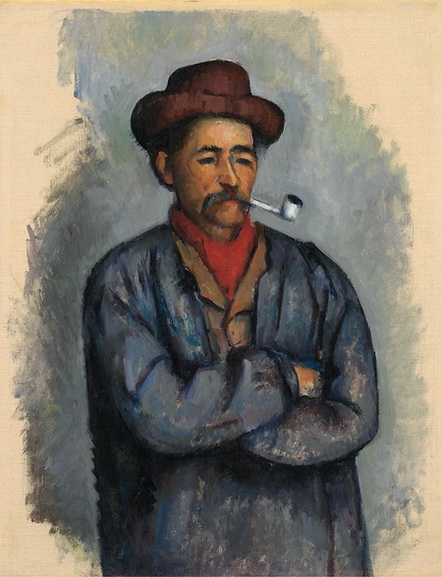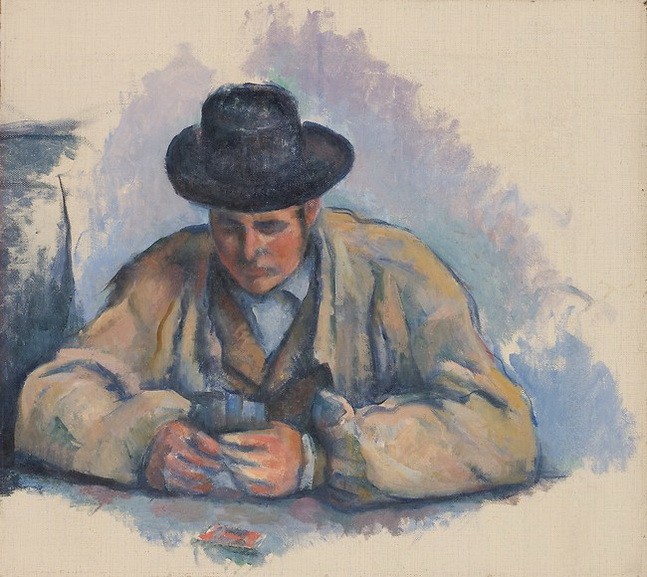Surveying The Card Players Paintings by Paul Cezanne
In 1906, the British art critic Roger Fry used the term "Post-Impressionism" for the first time, to describe an art movement which appeared between 1886 and 1905. It was mostly practiced by the French and was predominantly a rejection of dominant preoccupations of Impressionists such as light and color. This movement was led by Paul Cézanne who is considered the founding father of the same.
In the peak of Post-impressionist fervor around the 1890s, this gifted artist produced the famous painting The Card Players. It is a series consisting of five works differing in size, the number of depicted figures, and the environment where the game happens. Naturally, Cézanne created a number of preparatory sketches and drawings while working on the series which are considered as a sort of an introduction for his later and critically best-received artworks.

The Painting Series
The iconic composition is centered on Provencal peasants engaged in a game of cards; they are all male and are really immersed in a game with one of them holding a pipe in his mouth. Paul Cézanne hired local farm workers to pose for the paintings, and some of them were employed on the artist’s family estate.
This scene is practically extended from a motif dominant in 17th century Dutch and French genre painting of drunken gamblers in lousy taverns. According to scholars, the painting which hung in an Aix-en-Provence museum near the artist's home produced by one of the Le Nain brothers inspired Cézanne for this series. Unlike the 17th century paintings, Cézanne’s card players are instead serious and focused tradesmen looking down on cards rather than at each other in a more subtle environment, so the overall atmosphere is calm, almost contemplative. That was also achieved removal of alcohol and money the items which enhanced the historical genre.

The Card Players by Paul Cézanne on Display
The Courtauld Gallery in London and The Metropolitan Museum of Art in New York organized a joint exhibition in 2010–11 to display The Card Players paintings, along with early studies and sketches of the series. It was the first exhibition entirely devoted to the series and it encompassed all the paintings owned by the Courtauld, Metropolitan, and Musée d'Orsay under one roof. The remaining two versions from the Barnes Foundation and a private collection were shown as prints since the Barnes' policy is not to loan artworks and the collector was unwilling to lend the work.
The following list will feature each individual painting from the series and contribute more to better understanding of this Cézanne masterpiece.
Editors’ Tip: Cézanne's Card Players (The Courtauld Gallery)
Paul Cézanne’s famous series of paintings of peasants playing cards has long been considered among his most important and powerful paintings. The image of seated peasants, still and seeming silent, concentrating on their game of cards, can be seen as the human counterpart to the landscapes of Cézanne’s home countryside, notably Montagne Sainte-Victoire, which held such iconic significance for him. This catalogue accompanies a landmark exhibition at the Courtauld Gallery, London, and the Metropolitan Museum of Art, New York.
Featured image: Paul Cézanne - The Card Players, 1892–93. Oil on canvas, 97 × 130 cm, Private collection.
The Barnes Foundation
The largest of The Card Players series by Cézanne is held by The Barnes Foundation. It is also the most complex version, representing as many as five figures - three card players at the forefront, positioned in a semi-circle around the table, and two spectators behind; one of them on the right is a boy, while the man on the left is smoking a pipe and apparently is waiting for his turn.
The scholars debated whether Cézanne added the standing man to deepen the composition and to extend the observer’s view. Similarly to other works, it displays working-class men in loose-outfits with natural poses focused entirely on their game.
Featured image: Paul Cézanne - Card Players, 1890-92. Oil on canvas, 134 x 181,5 cm. The Barnes Foundation.
The Met Museum
The Metropolitan Museum of Art version of this painting includes four figures, and for a very long time was believed to be the second version of the famous series. It is similar to the Barnes painting, except it lacks the figure of the boy, and the gaze is more focused on the game with more dense space between the figures. All the men are hatted, and few objects are redacted.
This version is not that dim as the previous one and is saturated with blue tones. After it underwent X-ray and infrared studies, the layers of graphite underdrawing, as well as heavy layers of worked oil paint, were discovered indicating that Cézanne was unable to transfer the men easily.
Featured image: Paul Cézanne - Card Players, 1890-92. Oil on canvas, 65.4 cm x 81.9 cm. Metropolitan Museum of Art.
Musee d'Orsay
The painting which belongs to the Musée d'Orsay in Paris is probably the best known, most often reproduced, the smallest, and considered as the last version from the series. The spectator here is eliminated and the whole composition is brought down to bare essentials e.g. two figures immersed in their game. The scene seems balanced but asymmetrical, and while the man on the left is smoking a pipe (wearing more formal clothes), the man on the right is pipeless, and more loosely clothed. A wine bottle stands in the middle of the table dividing the scene.
Interestingly so, this version of The Card Players was stolen along with eight other Cézanne paintings in 1961 from a traveling exhibition. In order to honor a lost painting, the French government released a four-color postage stamp. Luckily, after the ransom was paid, all of the paintings were recovered a few months later.
Featured image: Paul Cézanne - Card Players, ca. 1894-1895. Oil on canvas, 47.5 cm x 57 cm. Musée d'Orsay.
Courtauld Institute of Art
The Card Players in the possession of the Courtauld Institute of Art is very much similar to the Musee d'Orsay version, both in terms of content and size. Like all the other works featuring the two players, this one also depicts a wine bottle as a sort of a dividing line between the two participants. It is slightly asymmetrical and somehow blurry, so it appears more as an aquarelle than a painting.
Featured image: Paul Cézanne - The Card Players, 1892–1895. Oil on canvas, 60 x 73 cm, Courtauld Institute of Art, London
Private collection
The last version on our list is held within a private collection, To be more accurate, this version of The Card Players was purchased by the Royal Family of Qatar in 2011 for an outstanding price estimated at between two hundred and fifty and possibly three hundred million dollars. At that moment, it holds the record as the highest price ever paid for a modern painting and was not surpassed until 2017. Like the Courtauld and Musee d'Orsay versions, it is a quite large and vibrant painting, and it differs from the rest because of the distinct coloring.
Featured image: Paul Cézanne - The Card Players, 1892–93. Oil on canvas, 97 × 130 cm. Private collection.
Can We Help?
Have a question or a technical issue? Want to learn more about our services to art dealers? Let us know and you'll hear from us within the next 24 hours.

